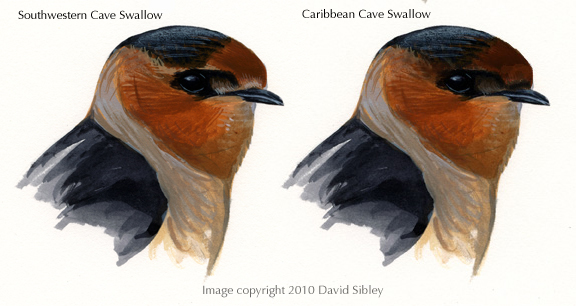Cave Swallow Petrochelidon fulva
Geographic Variation
Two subspecies groups of Cave Swallow occur in the United States:
- Mexican Cave Swallow Petrochelidon fulva pallida (=pelodoma)
- Caribbean Cave Swallow Petrochelidon fulva fulva group
Several additional subspecies are found in Mexico and South America.
Overview
The two subspecies groups show a number of average differences, but no single field mark is diagnostic, and judging such subtle differences in the field makes identification extremely challenging. Observers hoping to identify subspecies should focus on details of forehead color, but even that may be unreliable.

Distinguishing the Mexican and Caribbean subspecies of Cave Swallows has been the subject of a great deal of discussion in recent years, spurred by the remarkable vagrancy of large numbers of Cave Swallows north of their normal range. I have written about this before on the ID_Frontiers Listerver (in particular this post) and have spent many hours looking at specimens in several different museums.
Systematics
The two subspecies groups in the southern US have sometimes been suggested as candidates for separate species, and a recent study found biochemical evidence that Mexican and Caribbean groups do represent two different clades, and that Yucatan birds were allied with the Texas population, but at the same time “Gene flow was apparent among populations, especially between Texas and Florida.” (Kirchman et al 2000).
Based simply on observations in the field and in museums I do not think these populations are distinct enough to warrant species status, but further study could reveal differences. Voice is especially poorly studied.
Identification: Caribbean vs. Mexican Cave Swallows
Here is a list of differences between the subspecies, beginning with the most obvious and consistent, ending with some that are mere speculation or completely worthless.
- Forehead darker on Caribbean birds, (vs. paler on Mexican birds)
The darker forehead color of Caribean birds is difficult to distinguish from the black crown color. But both subspecies groups are variable, and some individuals overlap in forehead color.
- Frontal feathers (just above the nostrils) dark and blackish on Caribbean birds (vs. paler and whitish – contrasting with forehead – on Mexican)
It’s possible that the color of the tiny “frontal band” could help distinguish many birds, but this requires more testing.
- Rump darker on Caribbean birds (vs. paler – very close to Cliff Swallow – on Mexican)
Both are somewhat variable, so even though this feature distinguishes the vast majority of specimens in a museum tray, there are some paler Caribbean and darker Mexican birds that overlap in color. Combined with the difficulty of judging rump color in the field, this is probably no more than a suggestive indication of subspecies. No differences in feather pattern were found.
- Overall size smaller in Caribbean birds
Mexican birds average slightly smaller than Cliff Swallow, Caribbean birds even smaller. There is some overlap in size. Combined with other features size might be useful to build a case for one subspecies or the other, but it is only suggestive.
Untested or unreliable features:
At various times I have investigated the following as potential distinguishing features, but differences (if any) have remained unclear or unconfirmed:
- Color of cheeks and throat – often said to be darker on Caribbean birds, and this may be true in the broadest sort of average, but there is complete overlap, with many dark-throated Mexican birds and many pale-throated Caribbean birds.
- Color of flanks – said to be darker and more orange-toned on Caribbean birds, this (like throat color) may be true on average but is too variable and too hard to judge to be useful in the field.
- Extent of black on face – Along with the dark “frontal band” Caribbean birds may tend to have more black around the eye, and darker lores. This needs more testing.
- Streaked nape – Caribbean birds may tend to have dark streaks extending from the back of the cap along the nape, while Mexican birds have this area more smooth grayish. This is difficult to judge on specimens and requires some testing on the field.
- Nape color – Caribbean birds may have the nape slightly more orange-cinnamon while Mexican birds are more gray there, but this is probably just as variable as throat and flank color.
- White edges on tail feathers – All Cave Swallows have a short white margin on the inner web of the outermost tail feather, and it seems to be broader on Mexican Cave Swallows, at least on average, but differences are small and probably too variable to be useful. This would be nearly impossible to ascertain in the field.
- Voice – Howell and Webb (1995) suggested that there might be a difference in calls between Yucatan and Central Mexican birds. As far as I know this has never been rigorously tested.
Questions
Is there any difference in voice?
How reliable is the difference in “frontal band” color?
References
Howell, S.N.G. and S. Webb. 1995. A Guide to the Birds of Mexico and Northern Central America. Oxford University Press.
Kirchman, J. J., L. A. Whittingham, and F. H. Sheldon. 2000. Relationships among cave swallow populations (Petrochelidon fulva) determined by comparisons of microsatellite and cytochrome b data. Mol Phylogenet Evol. 14:107-121.


Hello,
I live in Georgia and have 2 birds building a nest on my porch. They match the cave swallow colors with the orange on the forehead and neck. From what I have found online, they list my area as a migration only.
Just curious if there is another swallow with similar markings in my area or maybe this birds territory is expanding.